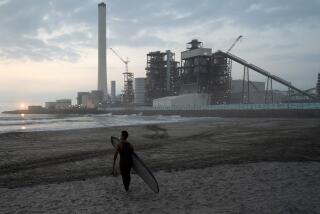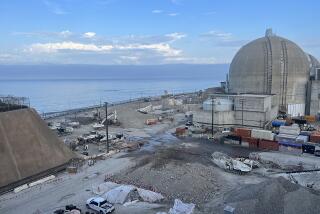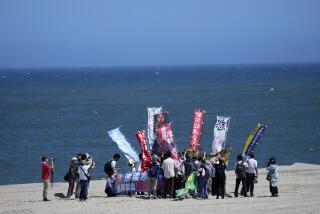Options are few to prevent Japan nuclear catastrophe
- Share via
Workers struggling to contain radioactive releases from the Fukushima power plant face two critical tasks to avoid turning a nuclear disaster into a catastrophe: preventing a runaway chain reaction into the nuclear fuel and maintaining a massive flow of seawater through the damaged pools and reactor vessels.
There are few options, none of them good.
“The most imaginative engineers in the world couldn’t have dreamed up a situation like this,” said Najmedin Meshkati, a USC professor and nuclear power expert.
But to deal with the grim reality at hand, utility workers and some of the top U.S. experts on nuclear reactors are working around the clock, attempting to calculate how to avoid further damage to the reactors and how to get sufficient cooling water through the plant with improvised water cannons, fire hoses and helicopters.
Photos: Japan grapples with crisis
If they can buy enough time, possibly several weeks, the nuclear material will cool off and become less radioactive, significantly reducing the risk of a further meltdown or chain reaction event. In coming years, experts agree, the damaged fuel will have to be removed from the plant to a safer location. Most experts say that the plant cannot be entombed in concrete, as was the Chernobyl plant after the 1986 disaster.
“If those water cannons are getting water to the cooling pools, they should keep that up,” said Elmer Lewis, an expert on nuclear power plant safety at Northwestern University in Evanston, Ill. “Until that fuel cools down, they have a real mess on their hands.”
Edward Morse, a professor of nuclear engineering at UC Berkeley, added that it would take huge amounts of water to compensate for the cracks in a containment pool that were uncovered by U.S. surveillance aircraft on Friday.
“The best thing to do is use as much of the Pacific Ocean as possible,” he said.
The other crucial task is to prevent the fuel in any of the reactors or pools from going critical, an event in which nuclear fission starts on its own and generates tremendous amounts of heat. Tokyo Electric Power Co., which operates the Fukushima plant, said it was importing tons of additional boron to ensure it could flood the reactor with the material, which absorbs neutrons that trigger the breakdown of uranium nuclei.
Not only will water absorb heat, it also forms a protective barrier against radiation, making it safer for workers at the plant, said David Lochbaum, head of nuclear safety policy at the Union of Concerned Scientists and a former nuclear plant operator.
“If they can cover the fuel, it will reduce the radiation levels and they can use the plant equipment,” Lochbaum said.
If the fuel overheats, as it has already done in some cases, it will release additional radioactive contamination into the environment.
But Per Peterson, chairman of the UC Berkeley nuclear engineering department, said he believes that most of the rods will not burn even if they are not covered by water. Only a few extremely radioactive rods may be vulnerable, said Peterson, who is advising U.S. officials on their response.
But if the fuel does overheat, that would destabilize the situation further and vastly complicate future efforts to clean up the plant.
While the spraying continues, workers continue to be exposed to relatively high levels of radiation, with doses of 20 millisieverts per hour measured in the control room at the site. Although workers are wearing protective gear that prevents them from coming in contact with radioactive particulates and are working for only one or two hours at a time, they are still being exposed to potentially lethal levels of gamma radiation.
The French nuclear agency IRSN said Friday that the Fukushima Daiichi plant had already released 10% as much radioactivity as Chernobyl, though the agency has been accused by some as being alarmist.
The cooling job may get easier when power is fully restored to the plant.
Company workers were able to lay a new power line to the plant early Saturday morning and began connecting it to reactor No. 2, whose containment vessel is believed to be cracked. They will then hook up the buildings housing reactors No. 1, No. 3 and No. 4, which they hope to have connected by the end of Sunday, they said.
But experts think it is unlikely that cooling pumps in the three reactors that were operating when the magnitude 9 Tohoku quake struck — Nos. 1, 2 and 3 — will work even with an outside source of electricity. Those pumps were probably damaged in a series of hydrogen explosions that occurred in the first four days of the crisis. The power lines could provide electricity to operate valves and controls, however.
There is no indication that the cooling pump servicing the cracked spent fuel pond on the upper floor of reactor No. 4 has been damaged, so officials hope to restore it to action.
Lochbaum said it should be possible to get enough pumping capacity to fill the pools and the reactors, even if they have breaches. In the case of the cracked spent fuel pool in No. 4, he said a simple rubber seal may account for some or all of the leakage and, if so, the seal could be reinflated once power is restored to the plant.
Morse, along with other top nuclear experts, spent the week debating how they would bring the Fukushima disaster under control. Morse said he tried to determine just how vulnerable zirconium fuel rods are to fire.
In a lab, he took zirconium shavings and exposed them to a blowtorch. The shavings did burn, but other experts question whether more substantial zirconium tubing used in reactors would burn.
Morse said he had a sample of that material in his pocket.
In the long run, some experts believe the Fukushima plant will have to be entombed. Within about a month of the Chernobyl accident, workers began dumping more than 5,000 tons of sand and concrete on the burning reactor to snuff out the flames and prevent further release of radiation.
But there are major differences between the two facilities that could make it very difficult to carry out a similar operation in Japan.
Chernobyl’s damaged reactor did not have a containment vessel, but was exposed to the open air. It was thus imperative to encase the plant in concrete to prevent further escape of radioactive ash.
The reactor cores at Fukushima, in contrast, are housed inside containment vessels made of steel and concrete. One of those may have been cracked, but the evidence so far suggests the cracking is modest, at worst.
Ironically, attempts to blanket those reactors with concrete at this point could wind up damaging the containment vessels more severely, cracking them open and allowing more radiation to escape, experts said.
Similarly, the spent fuel pool for reactor No. 4 may have run dry and may have holes in its side walls. Plus, the pond is 70 feet above the ground. Attempting to encase it in concrete could create massive problems.
Either workers would have to build some type of structure to support the concrete tomb or run the risk that the added weight of any extra concrete and sand piled onto the building would cause the top floors to crumble, allowing the fuel rods to break free.
Encasing the fuel rods in sand and concrete, furthermore, would trap heat and allow them to get much hotter than they are now, potentially enabling them to burn through the concrete and escape from their tomb.
Because the fuel rods and the reactors are so hot, the concrete would undergo a phenomenon called flash-set, in which it would solidify extremely rapidly.
But the result would be a material with a consistency much like gravel rather than stone.
“My gut feeling is, it’s a bad idea,” Lewis said.
Officials at Japan’s Nuclear and Industrial Safety Agency on Saturday said it was highly unlikely that workers could use massive amounts of sand or cement to smother the super-hot fuel inside the reactors or storage pools at the Daiichi plant any time in the near future.
“We believe it is not a realistic option,” said the agency’s Hidehiko Nishiyama.
Teruaki Kobayashi of Tokyo Electric Power Co. said the company had not ruled out the entombment strategy. But he added that the possibility was remote unless conditions at the plant changed substantially — for instance, if the fuel rods caught fire and began spewing radioactive ash everywhere.
More to Read
Sign up for Essential California
The most important California stories and recommendations in your inbox every morning.
You may occasionally receive promotional content from the Los Angeles Times.












